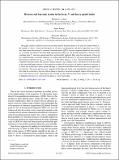Baryons and baryonic matter in the large Nc and heavy quark limits
Author(s)
Cohen, Thomas D.; Kumar, Nilay; Ndousse, Kamal K.
DownloadNdousse-2011-Baryons and baryonic matter in the large.pdf (389.4Kb)
PUBLISHER_POLICY
Publisher Policy
Article is made available in accordance with the publisher's policy and may be subject to US copyright law. Please refer to the publisher's site for terms of use.
Terms of use
Metadata
Show full item recordAbstract
This paper explores properties of baryons and finite density baryonic matter in an artificial world in which N[subscript c], the number of colors, is large and the quarks of all species are degenerate and much larger than Λ[subscript QCD]. It has long been known that in large N[subscript c] quantum chromodynamics (QCD), baryons composed entirely of heavy quarks are accurately described in the mean-field approximation. However, the detailed properties of baryons in the combined large N[subscript c] and heavy-quark limits have not been fully explored. Here some basic properties of baryons are computed using a variational approach. At leading order in both the large N[subscript c] and heavy-quark expansions the baryon mass is shown to be M[subscript baryon]≈N[subscript c]M[subscript Q](1-0.054 26α̃[subscript s][superscript 2]), where α̃[subscript s]≡N[subscript c]α[subscript s]. The baryon form factor is also computed. Baryonic matter, the analog of nuclear matter in this artificial world, should also be well described in the mean-field approximation. In the special case where all baryons have an identical spin-flavor structure, it is shown that in the formal heavy-quark and large N[subscript c] limit interactions between baryons are strictly repulsive at low densities. The energy per baryon is computed in this limit and found to be exponentially small. It is shown that when the restriction to baryons with an identical spin-flavor structure is dropped, a phase of baryonic matter exists with a density of 2N[subscript f] times that for the restricted case but with the same energy (where N[subscript f] is the number of degenerate flavors). It is shown that this phase is at least metastable.
Date issued
2011-07Department
Massachusetts Institute of Technology. Department of PhysicsJournal
Physical Review C
Publisher
American Physical Society
Citation
Cohen, Thomas, Nilay Kumar, and Kamal Ndousse. “Baryons and baryonic matter in the large N_{c} and heavy quark limits.” Physical Review C 84 (2011): n. pag. Web. 18 Nov. 2011. © 2011 American Physical Society
Version: Final published version
ISSN
0556-2813